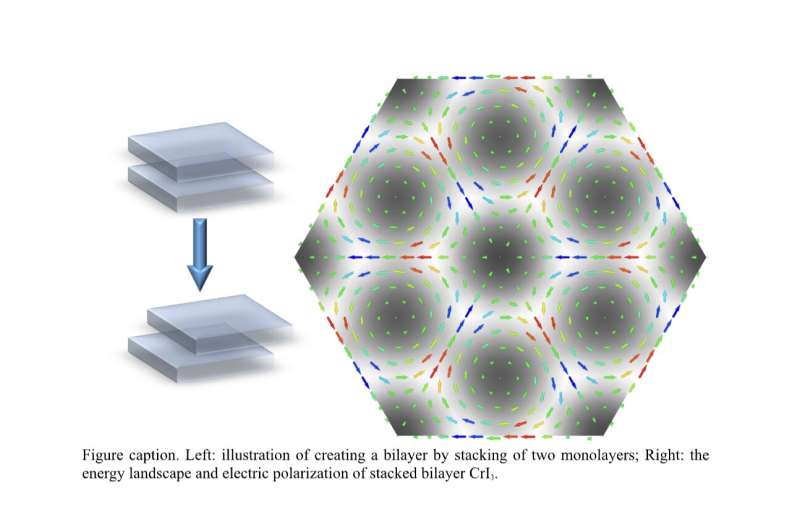April 24, 2023 feature
This article has been reviewed according to Science X's editorial process and policies. Editors have highlighted the following attributes while ensuring the content's credibility:
fact-checked
peer-reviewed publication
trusted source
proofread
A general theory to realize bilayer stacking ferroelectricity

Two-dimensional (2D) ferroelectrics, planar materials that have a spontaneous and reversible electric polarization, are extremely rare and yet could be extremely advantageous for the development of new nanoelectronics. Due to their ferroelectric properties and thin nature, they could be used to create high-performing, small and flexible devices, including high-density non-volatile memory, optoelectronics, ultra-low energy electronics and wearable technologies.
A research group at Fudan University and the Shanghai Qi Zhi Institute proposed a theory of bilayer stacking ferroelectricity (BSF), in which two stacked layers of the same 2D material, with different rotation and translation, exhibit ferroelectricity. This theory, presented in Physical Review Letters, could inform the synthesis of these advantageous materials and offer a generalizable guideline of how two stacked layers of the same 2D material can be engineered to exhibit ferroelectricity.
"A promising strategy in designing 2D ferroelectrics is the sliding ferroelectricity, which combines two monolayers of the same type and generates polarization by tuning the amount of their relative sliding," Changsong Xu and Hongjun Xiang who supervised the study, told Phys.org.
"However, studies adopting such concept still stay at the stage of examining materials one by one, which largely hinders the progress of this field. We thus come up with the idea to explore all the possibilities of bilayer stacking ferroelectricity with group theory, so that researchers can easily tell the polarization direction of a bilayer from the symmetry of corresponding monolayer."
To devise their general theory of bilayer stacking ferroelectricity, they systematically analyzed a series of 2D material groups using so-called group theory, an abstract algebra theory for studying sets of specific objects. This allowed them to pinpoint the rules underpinning the creation and annihilation of symmetries in bilayer structures, while also identifying possible combinations that would produce BSF.
"Materials usually crystalize in specific symmetries, such as mirror plane and rotational axis, which can be used to categorize the materials," Xu and Xiang explained. "For monolayers, it is the layer groups (there are 80 of them) that cover all the types of materials. Our general theory applies when one wants to stack two monolayers into a bilayer and check if there exists electric polarization."
The researchers' theory explains recent theoretical and experimental findings on sliding ferroelectricity. It also shows that in 2D ferroelectrics, the direction of the electric polarization of the bilayer could be totally different from that of the single layer. For instance, a bilayer could become ferroelectric if two centrosymmetric nonpolar monolayers are properly stacked.
"We obtain general rules of the destruction of original symmetry operations of the monolayer and emergence of new symmetry operations in the bilayer," Xu and Xiang said. "Our general theory of bilayer stacking ferroelectricity covers all the possibilities of bilayer ferroelectricity. With such theory, given the layer group of any monolayer, one can tell what kind of stacking operations will result in ferroelectricity in the corresponding bilayer and along which direction the ferroelectric polarization points."
To demonstrate the effectiveness of their general theory, the researchers ran a series of simulations. These simulations predicted that ferroelectricity could be introduced in the prototypical 2D ferromagnetic centrosymmetric material CrI3 using a stacking strategy.
They also showed that the out-of-plane electric polarization in this bilayer system is interlocked with the in-plane electric polarization. In other words, the out-of-plane polarization of the stacked CrI3 bilayer system could be manipulated by applying an in-plane electric field to it.
The general theory of bilayer stacking ferroelectricity introduced by Xu, Xiang and their colleagues could soon guide new studies aimed at creating bilayer ferroelectrics. This could in turn facilitate the development of new highly performing devices based on these promising 2D material systems.
"On one hand, the proposed general theory indicates many possibilities to create bilayer ferroelectricity and it thus will be appealing to apply such theory to various 2D systems," Xu and Xiang added. "On the other hand, the successful application of group theory method to 2D ferroelectricity encourages us to use it for predicting other fascinating physical properties."
More information: Junyi Ji et al, General Theory for Bilayer Stacking Ferroelectricity, Physical Review Letters (2023). DOI: 10.1103/PhysRevLett.130.146801
Journal information: Physical Review Letters
© 2023 Science X Network




















